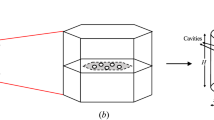Abstract
Syntactic foams are attractive for applications that require materials with high impact strength and low thermal conductivities. Because syntactic foams are manufactured by dispersing hollow microspheres in a resinous matrix, their characteristics are functions of the type and relative amounts of these materials. In this work, a discussion of an experimental approach to measure the thermal conductivity of three-phase syntactic foams (hollow carbon microspheres in a porous APO-BMI binder, analysis of the data and the comparison to predictive models are presented. The thermal conductivity of three-phase syntactic foams is measured using a Holometrix© steady-state heat flow meter. The experimental data are found to be accurate to within a reasonable range of experimental error and are compared to three of the more reliable predictive models that have been used successfully to estimate the thermal conductivity of similar foams. It is observed that the model predictions at lower temperatures are more accurate as compared to those at higher temperatures. Also, that a model based on the concept of self-consistent field theory better predicts the thermal conductivity of syntactic foams than one based on resistance-in-series. Sensitivity studies indicate a strong dependency of the thermal conductivity of the three-phase foams on the thermal conductivity of the carbon used in the microspheres.
Similar content being viewed by others
References
K. ASHIDA, Syntactic foams. “Handbook of Plastic Foams: Types, Properties, Manufacture and Applications” (Noyes Publications, Park Ridge, NJ, 1995) p. 147.
S. KLARSFELD, Guarded hot plate method for thermal conductivity measurements. “Compendium of Thermophysical Property Measurement Methods: Survey of Measurement Techniques” (Plenum Press, New York, NY, 1984) Vol. 1, p. 169.
Operation and Maintainence Manual, TCA-200-LT-A Guarded Heat Flow Meter (Bedford, MA).
A. G. LEACH, Thermal conductivity of foams-I: Models for heat conduction. Journal of Physics D: Applied Physics 26 (1993) 733–739.
L GLICKSMAN, M. SCHUETZ and M. SINOFSKY, Radiation heat transfer in foam insulation. International Journal of Heat and Mass Transfer 30 (1987) 187–197.
J. D. FELSKE, Effective thermal conductivity of composite spheres in a continuous medium with contact resistance. Ibid. 47 (2004) 3453–3461.
Z. HASHIN, Assessment of self consistent scheme approximation: Conductivity of particulate composites. Journal of Composite Materials 2 (1968) 284–300.
Y. BENVENISTE and T. MILOH, Effective conductivity of composites with imperfect contact at the constituent interfaces. International Journal of Engineering Science 24 (1986) 1537–1552.
V. S. SHABDE, Experimental determination of the thermal conductivity of syntactic foams. Technical report, TTU, Department of Chemical Engineering, Lubbock, TX, 2005.
Y. AGARI and T. UNO, Estimation of thermal conductivities of filled polymers. Journal of Applied Polymer Science 32 (1986) 5705–5712.
S. C. CHENG and R. I. VACHON, The prediction of the thermal conductivity of two and three phase solid heterogenous mixtures. International Journal of Heat and Mass Transfer 12 (1968) 249–264.
C. MAXWELL, “A Treastise on Electricity and Magnetism” (Clarendon Press, Oxford, 1892).
C. Y. ZHAO, T. J. LU, H. P. HODSON, and J. D. JACKSON, The temperature dependence of effective thermal conductivity of open-celled steel alloy foams. Material Science and Engineering A 367 (2004) 123–131.
D. DOERMANN and J. F. SCADURA, Heat transfer in open cell foam insulation. Journal of Heat Transfer (1996) 83–93.
H. C. HOTTEL and A. F. SAROFIM, “Radiative Transfer” (McGraw-Hill, New York, NY, 4th edition, 1967).
W. TAO, H. HSU, C. CHANG, C. HSU, and Y. LIN, Measurement and prediction of thermal conductivity of open-cell rigid polyurethane foam. Journal of cellular Plastics 37 (2001) 310–331.
M. KYO, T. KATOH, T. KASHIWAGA, and Y. KAMATA, Effective thermal conductivity of composite foam. Heat Transfer: Japanese Research 23 (1994) 258–276.
A. G. LEACH, Thermal conductivity of foams-II: The thermal conductivity of a layer mineral foam. Journal of Physics D: Applied Physics 26 (1993) 740–745.
R. TSUKUDA, S. SUMIMOTO, and T. OZAWA, Thermal conductivity and heat capacity of abs resin composites. Journal of Applied Polymer Science 63 (1997) 1279–1286.
O. ALMANZA, M. A. RODR GUEZ-P REZ, and J. A. SAJA, Applicability of the transient plane source method to measure thermal conductivity of low-density polyethylene foams. Journal of Polymer Science 42 (2004) 1226–1234.
W. R. DAVIS, Hotwire method of measurement of thermal conductivity of refractory materials. “Compendium of Thermophysical Property Measurement Methods Survey of Measurement Techniques” (Plenum Press, New York, NY, 1984) Vol. 1, pp. 231–254.
A. Z. ZINCHENKO, Effective conductivity of loaded granular materials by numerical simulation. Philosophical Transactions of the Royal Society of London 356 (1997) 2953–2998.
A. EUCKEN, Thermal conductivity of ceramic refractory materials; calculation from thermal conductivity of constituents. Ceramic Abstracts 11 (1932).
S. J. KLINE, The purposes of uncertainty analysis. Journal of Fluids Engineering 107 (1985) 153–160.
L. R. OTT and M. LONGNECKER, “Statistical Methods and Data Analysis” (Duxbury, CA, 5th edition, 2001).
C. RESEWSKI and W. BUCHGRABER, Properties of new polyimide foams and polyimide foam filled honeycomb composites. Materials Science and Engineering Technology 34 (2003) 365–369.
S. C. CHENG and R. I. VACHON, A technique for predicting the thermal conductivity of suspensions, emulsions and porous materials. International Journal of Heat and Mass Transfer 13 (1969) 537–546.
H. O. PIERSON, “Handbook of Carbon, Graphite, Diamond and Fullerenes—Properties, Processing and Applications” (New York, NY, 1st edition, 1993).
Author information
Authors and Affiliations
Corresponding author
Rights and permissions
About this article
Cite this article
Shabde, V.S., Hoo, K.A. & Gladysz, G.M. Experimental determination of the thermal conductivity of three-phase syntactic foams. J Mater Sci 41, 4061–4073 (2006). https://doi.org/10.1007/s10853-006-7637-x
Published:
Issue Date:
DOI: https://doi.org/10.1007/s10853-006-7637-x




